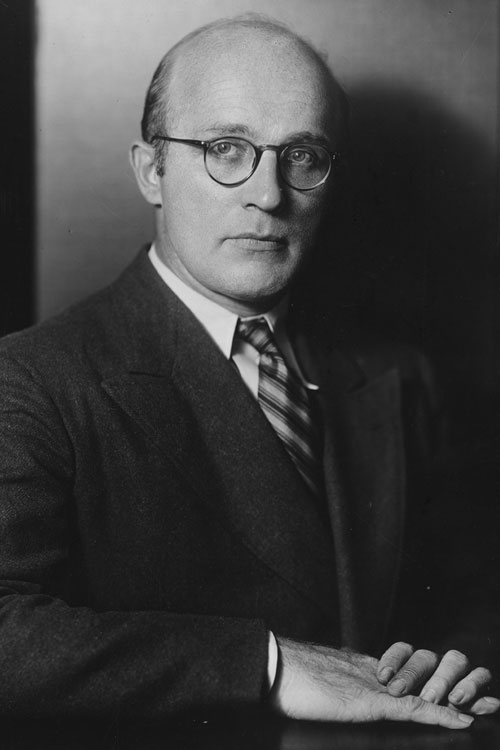The Molecule Bender
Sculptor Byron Rubin ’65 traces the fateful symmetries that govern life—and death.
Proteins. Even now, as you read this sentence, an overworked sophomore is likely holed up in the Arthur Scott Chem Lab, marveling over how these microscopic workhorses pulse with tens of thousands of intricately arrayed atoms. They are the building blocks of life, the mortar of history. The hemlock that Socrates quaffed on his last fatal evening? It killed the old boy only because it contained a toxin, coniine, that bound to receptor proteins in his nervous system. The bubonic plague? That, people, was a matter of fleas passing on to humans a bacteria, yersinia pestis, whose noxious proteins shut down victims’ immune systems.
Proteins were first described by the Dutch chemist Gerardus Mulder in 1838, but their true nature remained elusive. In the late 1960s, the study of protein molecules—protein crystallography, it’s called—was still so nascent that, of the millions of proteins in the universe, science knew the molecular structure of fewer than ten. The field was thirsty for pioneers, and Byron Rubin ’65 became one of them, thanks in part to his facility with bending wire.
In the years after Byron left Reed, as he earned a PhD at Duke, computers were primitive. Chemists had figured out the formulas for many important proteins. But even if they knew that hemoglobin was C2952H4664N812O832S8Fe4, the formula yields no clue to the molecule’s structure—which determines how it actually works.
To attain visual models, biochemists used wooden dowels and plastic balls to create awkward replicas that resembled scale-model roller coasters. “Building one of those models took months,” Byron groans.
In 1972, in a flash of insight, he realized that he could capture the nuance, the music of proteins if he rendered each one with a single strategically bent segment of eighth-inch cold-rolled steel wire. He even invented a tool for flexing the wire. Byron’s Bender, as the device is still known, features two vices to clench wire in place and a rotating anvil with which to bend it. Still manufactured by the Charles Supper Company of Boston, the Bender was a vital tool in the days before computer imagery, and it helped crystallographers push the frontiers of knowledge so that today they’ve mapped the structure of 120,000 different proteins.
By inventing the Bender, Byron also pioneered a new kind of art—a form that endeavors to capture the structure of complex molecules. Becoming the Picasso of proteins is an unlikely role for a kid raised in Chicago by parents who ran a chain of necktie shops. Growing up, Byron betrayed no aptitude for the visual arts or machinery; he didn’t know how to change the oil in a car. Truth is, when Byron talks about his sculptures, he scarcely regards them as rooted in the art world. He doesn’t refer to Calder or Brancusi or other legendary sculptors. Instead, he effuses about the “beauty” of proteins. “Isn’t that one pretty?” he’ll say, dewy-eyed with delight. “Isn’t it just amazing?”
Bryon is a chemist to his core, and for that we can thank his Reed thesis adviser, Prof. Arthur Scott [1923–79]. Brilliant, avuncular, and slightly pudgy, Scott took a wayward Byron under his wing. Freshman year, he guided the youngster into the Hauser Library and, in showing him how to use it, lifted from the shelves a paper on how to do gravimetric determinations of barium. (“I was in awe,” Byron remembers.) One Halloween, Byron and his girlfriend were entrusted with passing out candy at the Scott home. Later, as Byron angsted, senior year, over his future, Scott made an offhanded but consequential remark. “Well, Byron,” he said, “chemistry’s been very good to me.”
Byron’s introduction to large-scale sculpting was almost as serendipitous—and it came in 1992, a decade after improved computer imaging had made the Bender a tool for amateurs. Byron was by then a pharmaceutical researcher for Eastman Kodak. With others, he determined the molecular structure of a protein called collagenase, which they hoped could be a treatment for arthritis. To celebrate, he spent a couple days shaping a model of the molecule. “I just wanted a nice thing to look at,” he says.
But when a colleague spied Byron’s gleaming brass and copper creation, he told Byron he had a favorite molecule he wanted sculpted. Two weeks after Byron delivered that commission, another request came in.
Twenty-seven years later, Byron has made multiple pieces for Pfizer and has also done work for Merck & Co. His home workshop outside Rochester, New York, sprawls over 2,800 square feet, and he says that his wife, Sandy, excoriates him for his single-minded focus on sculpting molecules. She asks, “Can’t you make something that’s just artistic?”
He cannot. But his chemist’s instincts may save him in the end. In 2017, Byron was diagnosed with an aggressive prostate cancer. He had his tumorous prostate removed, and he also read over 100 scientific papers related to his cancer. He had his DNA sequenced and learned that his body was deficient in one gene, CDK12, which is critical to the synthesis of proteins needed for DNA repair.
When Byron goes to his urologist now, the doctor is both student and caretaker. “Tell me what you’ve learned,” he says to Byron. After Byron read a groundbreaking article on CDK12 in Nature, he told his doc that immunotherapy can check mutation caused by CDK12 deficiency. “It’s very successful,” he says. “It could work.”
But if it doesn’t? Byron knows how the particles of life are built, and he knows that entropy freights the power to tear life apart. “If immunotherapy doesn’t work,” he says flatly, “I’ll probably die.” He pauses for a moment, ruminating. There are still more sculptures to make, more symmetries to capture. At the molecular level, the world is an intricate, glittering labyrinth, and Byron can’t rest until he traces the path to its heart.
Tags: Alumni

